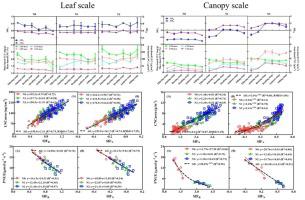当前位置:
X-MOL 学术
›
Eur. J. Agron.
›
论文详情
Our official English website, www.x-mol.net, welcomes your feedback! (Note: you will need to create a separate account there.)
Estimation of leaf nitrogen content and photosynthetic nitrogen use efficiency in wheat using sun-induced chlorophyll fluorescence at the leaf and canopy scales
European Journal of Agronomy ( IF 5.2 ) Pub Date : 2021-01-01 , DOI: 10.1016/j.eja.2020.126192 Min Jia , Roberto Colombo , Micol Rossini , Marco Celesti , Jie Zhu , Sergio Cogliati , Tao Cheng , Yongchao Tian , Yan Zhu , Weixing Cao , Xia Yao
European Journal of Agronomy ( IF 5.2 ) Pub Date : 2021-01-01 , DOI: 10.1016/j.eja.2020.126192 Min Jia , Roberto Colombo , Micol Rossini , Marco Celesti , Jie Zhu , Sergio Cogliati , Tao Cheng , Yongchao Tian , Yan Zhu , Weixing Cao , Xia Yao

|
Abstract Leaf nitrogen content (LNC), an indicator for the amount of photosynthetic proteins, plays an important role to understand plant function and status. In previous studies, vegetation indices (VIs) have been demonstrated to monitor LNC non-destructively, but which is influenced by backgrounds, and lacks specificity for nitrogen stress. In this study, sun-induced chlorophyll fluorescence (SIF), a novel technique related to plant physiology state, was proposed to estimate area-based and mass-based LNC at both leaf and canopy scales. In addition, SIF indices were evaluated to retrieve photosynthesis nitrogen use efficiency (PNUE), an important trait of leaf economics and physiology, based on the relationships between SIF, photosynthesis, and LNC. This study was conducted on two field experiments of winter wheat with different nitrogen regimes in Rugao, Jiangsu Province, China during 2016-2017 and 2017-2018 growing seasons. We took measurements of SIF, reflectance, biochemical and growth structural parameters at the leaf and canopy scales. The SIF signal was collected using ASD (Analytical Spectral Devices, Boulder, CO, USA) and QEpro (Ocean Optics, Dunedin, FL, USA) spectrometers at the two observational scales, with a full width at half maximum (FWHM) of 1.4 nm and 0.13 nm, respectively. SIF indices were calculated based on the SIF signal extracted at two oxygen absorption bands. Our results demonstrated that area-based LNC was better related to SIF indices and VIs than mass-based LNC. SIF ratio index (SIFR) and normalized SIF index (SIFN), defined as SIF761/SIF687 and (SIF761-SIF687)/(SIF761+SIF687) separately, performed better in monitoring area-based LNC at the two observation scales than CIred edge, which performed best in VIs group. Compared with CIred edge, the best estimation accuracy of SIF indices for area-based LNC increased by 0.08 and 0.02 at the leaf and canopy scales, separately. And when using SIFR and SIFN to monitor area-based LNC, there is no saturation phenomenon, which occurs using traditional VIs. From the whole range of data, area-based LNC was closely related to several plant traits (leaf: area-based leaf chlorophyll content (LCC) (LCCarea), leaf mass per area (LMA); canopy: area-based canopy LCC (CCCarea), leaf area index (LAI), leaf dry weight (LDW) per unit soil area, and LMA), which was consistent with previous studies. However, in specific group with fixed area-based LCC value, although area-based LNC almost wasn’t significantly correlated with these traits, SIFR and SIFN were instead always highly correlated with area-based LNC in each small datasets on two observation scales (leaf scale: R2>0.50, R2>0.46; canopy scale: R2>0.41, R2>0.42). Thus, the contribution of SIFR and SIFN to estimate area-based LNC wasn’t only the plant traits listed, but also other internal characters, like nitrogen allocation and proportion. Moreover, SIFR and SIFN were proved to be potential detectors to retrieve PNUE. These findings would provide us a new perspective for understanding plant nitrogen status from remote sensing observations, detecting plant function and managing precise agriculture.
更新日期:2021-01-01


























 京公网安备 11010802027423号
京公网安备 11010802027423号